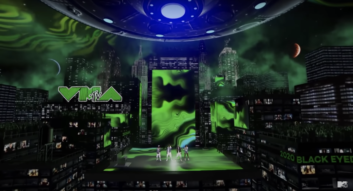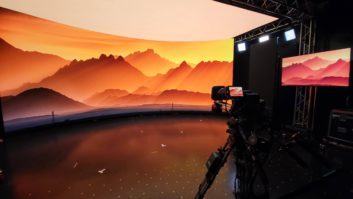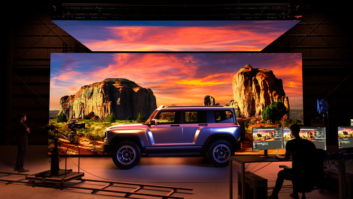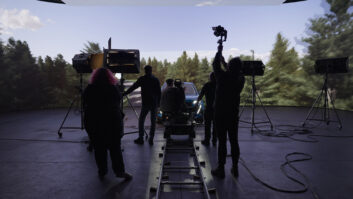The MTV Video Music Awards were the first major US awards show to take place since the onset of the coronavirus pandemic in the country. XR Studios selected the disguise xR workflow, powered by the latest disguise gx 2c media server, as the central technology hub to deliver the socially distant ceremony.
The two-hour show was filmed across a number of locations in New York as well as two xR stages in California, in order to comply with health and safety guidelines issued under the Covid-19 pandemic.
The creative concept
 VMA creative director Paul Caslin began brainstorming how to expand the show into AR in January 2020, seven months before the broadcast date. By June 2020 he knew he needed to explore the full concept of xR to be able to deliver a show with no audience that could still bring the buzz and energy of a live event to viewers at home.
VMA creative director Paul Caslin began brainstorming how to expand the show into AR in January 2020, seven months before the broadcast date. By June 2020 he knew he needed to explore the full concept of xR to be able to deliver a show with no audience that could still bring the buzz and energy of a live event to viewers at home.
Caslin decided to use xR to recreate a virtual cityscape set design (originally envisioned for the live show), featuring various NYC landmarks and a giant Moonman (the VMAs’ trophy statuette). This served as the epicentre of the show; where the awards were presented.
How the show came together
XR Studios and Silent Partners Studio set up a 70ft x 40ft infrastructure in Los Angeles, making it the largest xR stage constructed at the time. The two teams then worked together to build the virtual content and deliver the awards stage in xR, while also enabling other creative teams to craft artist performances in xR environments.
The challenge
Exploring new territories
“We were building the biggest xR stage to date and exploring completely new territories with the software,” Scott Millar of XR Studios explains. Having pioneered the application of xR in live entertainment, the team had a level of confidence in the technology that they had to translate for the VMA creative team. “We had to give the producers looking into the camera the same set-up that they would have had on-site for the live show.”
“No one had ever done anything that big with this technology before. It was definitely a new challenge for us to work with the vendors and the development teams to push the technology forward,” adds Cory FitzGerald of XR Studios.
While the show was filmed in LA, several production crew members and executives worked remotely. “Although we stayed in constant communication, the main struggle was not having that peripheral vision of everything that was happening on-site,” says Scott who worked from his home in London.
The solution
Creating an immersive virtual world
“We were able to create a workflow that allowed us to film a TV show in an entirely new medium using tools everyone could relate to, and in a format that was familiar,” Cory explains.
The disguise gx 2c media server powered real-time graphics from Notch and transferred them to the LED video screens and the virtual set extension beyond the LEDs. The set extension was enabled by disguise’s camera calibration workflow and its ability to blend LED with virtual environments to create whole new worlds. This created a vast and immersive virtual world on camera that fans could view from their screens at home.
“disguise’s xR workflow empowers traditional media server and content creation processes while adding layers of augmented and mixed reality. This allows flexibility and builds in dependability for live entertainment,” Scott explains.
Results
 Thanks to the agnostic nature of disguise and its RenderStream video-over-IP protocol, producers were able to utilise the best render engines for the task at hand without disruption to the overall workflow. While Notch VFX was chosen as the real-time rendering engine for the awards stage itself as well as sets from Miley Cyrus, The Black Eyed Peas and Doja Cat, Unreal Engine was used on set for Lady Gaga and DaBaby.
Thanks to the agnostic nature of disguise and its RenderStream video-over-IP protocol, producers were able to utilise the best render engines for the task at hand without disruption to the overall workflow. While Notch VFX was chosen as the real-time rendering engine for the awards stage itself as well as sets from Miley Cyrus, The Black Eyed Peas and Doja Cat, Unreal Engine was used on set for Lady Gaga and DaBaby.
The disguise software was key not only to the camera calibration but also in colour balancing and overall compositing of real-time content tools. To meet the creative and technical requirements of the team, a number of custom updates had been made to the software that ultimately led to the development of release 17.4 a month later.
The new wave of live entertainment
The project was successful on a level of scale in terms of the size of the stage, the number of tracked cameras and the ambitious number of live performances and awards presentations,” says JT Rooney of Silent Partners Studio. The 2020 VMAs paved the way for future shows to combine virtual and real worlds to deliver unforgettable viewing experiences.
Success
Having already delivered ground-breaking virtual productions for performances by Katy Perry and The Black Eyed Peas in 2020, the VMAs marked another successful collaboration between XR Studios, Silent Partners and disguise.
Watched by over 6.4 million people who tuned into the live stream, the event became the second most talked about show on social media in 2020 (at the time of writing).
“This was the largest and most complex xR show that we have ever had to support,” says Jamie Sunter, disguise senior support specialist. “We had Support and Development teams working in LA and the UK ensuring we had maximum coverage over both timezones. We utilised the xR stage at our London HQ to verify fixes and reproduce issues that were being seen on-site. In LA we had a constant support presence at the awards themselves as well as offering access to our LA-based Support team remotely.”







